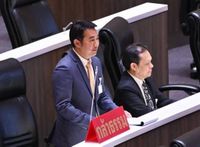On October 21, 2025, Thailand found itself at the crossroads of crisis management and digital transformation, as government agencies and political leaders took decisive steps to address both immediate and long-term challenges facing the nation. From the flood-ravaged far north to the bustling streets of Bangkok, a series of coordinated efforts unfolded—each aiming to provide relief, restore infrastructure, and set the country on a smarter, more resilient path.
In a move that many see as a milestone for disaster relief policy, the Center for Disaster Victim Assistance (ศชภ.) convened a high-level meeting to hammer out permanent guidelines for compensating citizens who annually sacrifice their land as floodwater retention zones. According to Bangkok Biz News, Deputy Prime Minister Sophon Sarum chaired the session, joined by top officials including Yupha Taweewattanakitborvon, Permanent Secretary to the Prime Minister’s Office, and representatives from all relevant agencies. The goal: to accelerate and streamline aid for those hit hardest by recurring floods, especially in regions where water management is a perennial struggle.
“The government, under the leadership of Prime Minister Anutin Charnvirakul, is placing the highest priority on assisting disaster victims, particularly those affected by the current flooding situation,” Sophon Sarum declared during the meeting, as reported by Bangkok Biz News. He underscored that this approach aligns with the directives issued by the National Disaster Management Committee in early October, which called for urgent action on water management—ranging from controlling sluice gates to maximizing water diversion and drainage efficiency.
The most significant outcome from the meeting was the approval of a new framework for swift, targeted compensation. For the first time, citizens who routinely allow their land to be used as floodwater retention areas will be eligible for annual compensation without having to seek case-by-case approval. This change, rooted in cabinet resolutions from late September, is expected to reduce bureaucratic delays and provide more predictable support for affected communities. The Center for Disaster Victim Assistance will now serve as a centralized, one-stop hub, integrating government and private sector efforts to deliver aid quickly and efficiently.
Meanwhile, the northern province of Mae Hong Son was in the spotlight for a different reason. At 10:30 AM, a parliamentary session in Bangkok saw MP Pakorn Jeenakham of Mae Hong Son’s first district take the floor to thank two cabinet ministers—Akara Promphao, Minister of Social Development and Human Security, and Nares Thamrongthipphayakhun, Deputy Minister of Agriculture and Cooperatives—for their hands-on response to local flood disasters. According to Banmuang, Pakorn didn’t mince words as he relayed urgent pleas from his constituents: “I have received complaints from the people about two major issues,” he said. “First, the Ministry of Transport must expedite repairs to the Ban Huai Pong Bridge, which connects main highways 108 and 1095 and was heavily damaged by recent floods.” The loss of this vital link, he argued, has made travel and goods transport nearly impossible for locals.
Pakorn’s second request was equally pressing: he urged the government to bring back commercial flights to Mae Hong Son, especially in the key districts of Mueang Mae Hong Son and Pai. “Restoring air service would not only ease travel for residents and tourists,” he explained, “but also help revive the local economy and tourism sector.” His remarks were a clear call for coordinated action—one echoed by many in the flood-affected northern border region, where infrastructure and connectivity have become lifelines for recovery.
While the country grappled with disaster response, another major initiative was quietly taking shape in the heart of Thailand’s urban centers. On the same day, the Department of Land Transport launched its ambitious ‘Smart City’ pilot project. As reported by Bangkok Biz News, this program aims to overhaul public transportation services and integrate smart technologies to tackle chronic traffic woes. The pilot, which kicked off in select areas on October 21, 2025, promises a suite of one-stop services designed to make getting around easier for everyone—from daily commuters to occasional travelers.
“This initiative is part of the government’s plan to enhance urban living standards and reduce traffic congestion,” the Department of Land Transport announced. The project is expected to bring together real-time traffic management, digital ticketing, and better data integration, all under a single, user-friendly umbrella. By streamlining transportation services, officials hope to not only improve quality of life but also set a new standard for smart governance in rapidly growing Thai cities.
These forward-looking policies found resonance in the political arena as well. On October 21, a major political event unfolded in Bangkok, drawing eyes from across the nation. According to Banmuang, a two-hour speech by a political figure named Bamrung focused on the urgent need for political reform and better governance. The event, streamed live on Facebook, attracted significant public attention and sparked lively discussions about the future of Thai public administration.
Bamrung’s speech zeroed in on strategies to boost government transparency and public service efficiency—echoing themes that have become increasingly important in the wake of recent crises. He emphasized the role of smart governance and digital transformation, arguing that these are essential tools for building trust and delivering results in times of uncertainty. “We must embrace digital tools and transparent processes if we want to serve the people effectively,” Bamrung asserted, according to Banmuang.
The convergence of these events—the push for smarter disaster relief, the drive to rebuild critical infrastructure, and the embrace of digital transformation—paints a picture of a nation determined to learn from adversity. Each initiative, whether born out of necessity or vision, reflects a broader shift in Thai governance: one that values speed, integration, and a willingness to adapt.
Yet challenges remain. For residents of Mae Hong Son, the road to recovery is still long, and the return of air travel could make all the difference. For city dwellers, the promise of a ‘Smart City’ is tantalizing, but its success will depend on execution and public buy-in. And for the country’s political leaders, the drive for transparency and efficiency will be tested by the complexities of real-world implementation.
Still, as October 21, 2025, drew to a close, there was a palpable sense of momentum. By combining rapid disaster response, infrastructure repair, and digital innovation, Thai officials and citizens alike are charting a course toward a more resilient, connected, and forward-looking future.




